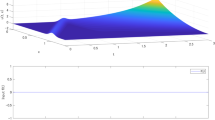Abstract
In this paper, we develop an alternative algebraic approach to feedback stabilization problems of linear parabolic boundary control systems. The control system is general in the sense that no Riesz basis associated with the elliptic operator is expected. The control system contains a finite dimensional dynamic compensator, the dimension of which has been so far determined only by the actuators on the boundary. One of the purposes of the paper is to show a new alternative scheme that the dimension of the compensator could be determined by the sensors on the boundary: it leads to a realization of stabilizing compensators of lower dimension by comparison. This is achieved by introducing a new operator equation connecting two states of the controlled plant and the compensator. The other purpose is a generalization of the condition posed on the sensors. When the elliptic operator admits generalized eigenfunctions, the sharpest criterion is proposed on the minimum choice of the necessary number of the sensors. In fact, only one sensor is enough for the stabilization in the best case (the algebraic multiplicities of the corresponding eigenvalues may, of course, be greater than 1).
Similar content being viewed by others
Notes
There is an attempt to draw out a class of elliptic operators equipped with Riesz bases (see, for example, [11, 14]). It seems that these operators are limited to a narrow class such as self-adjoint operators plus relatively small perturbations. Along a similar line, there are also classical results on when a little perturbed system of a Riesz basis would form a Riesz basis [29].
Actually, the spectrum \(\sigma (L)\) lies inside some parabola with the real axis as the axis of symmetry.
References
Agmon S (1965) Lectures on elliptic boundary value problems. Van Nostrand, Princeton
Bhatia R, Rosenthal P (1997) How and why to solve the operator equation \(AX-XB=Y\). Bull Lond Math Soc 29:1–21
Curtain RF (1984) Finite dimensional compensators for parabolic distributed systems with unbounded control and observation. SIAM J Control Optim 22:255–276
Fujiwara D (1967) Concrete characterization of the domain of fractional powers of some elliptic differential operators of the second order. Proc Jpn Acad Ser A Math Sci 43:82–86
Gilbarg D, Trudinger NS (1983) Elliptic partial differential equations of second order, 2nd edn. Springer, New York
Grisvard P (1967) Caractérisation de quelques espaces d’interpolation. Arch Rational Mech Anal 25:40–63
Itô S (1992) Diffusion equations. American Mathematical Society, Providence
Kato T (1961) A generalization of the Heinz inequality. Proc Japan Acad Ser A Math Sci 37:305–308
Krstic M, Smyshlyaev A (2008) Boundary Control of PDEs: a course on backstepping designs. SIAM, Philadelphia
Lasiecka I, Triggiani R (2000) Control theory for partial differential equations. I: Abstract parabolic systems. Cambridge University Press, Cambridge
Léautaud M (2010) Spectral inequalities for non-selfadjoint elliptic operators and application to the null-controllability of parabolic systems. J Funct Anal 258:2739–2778
Levinson N (1940) Gap and density theorems. American Mathematical Society, Colloquium Publications, New York
Luenberger DG (1966) Observers for multivariable systems. IEEE Trans Autom Control AC-11:190–197
Markus AS (1988) Introduction to the spectral theory of polynomial operator pencils. Transl. Math. Monogr. American Mathematical Society, Providence
Nambu T (1985) On stabilization of partial differential equations of parabolic type: boundary observation and feedback. Funkcial Ekvac 28:267–298
Nambu T (1994) Approximation algorithm for an infinite-dimensional operator equation \(XL-BX=C\). Math Control Signals Syst 7:76–93
Nambu T (2004) An \(L^2(\Omega )\)-based algebraic approach to boundary stabilization for linear parabolic systems. Q Appl Math 62:711–748
Nambu T (2005) A new algebraic approach to stabilization for boundary control systems of parabolic type. J Diff Equ 218:136–158
Nambu T (2007) Stability analysis of linear parabolic systems and removement of singularities in substructure: static feedback. J Diff Equ 238:257–288
Nambu T (2011) A note on the minimum number of the actuators for stabilization in linear parabolic boundary control systems. SICE JCMSI 4:349–352
Nambu T (2012) Equivalence of two stabilization schemes for a class of linear parabolic boundary control systems, Bull Polish Acad Sci Math 60:187–199
Raymond J-P, Thevenet L (2010) Boundary feedback stabilization of the two dimensional Navier-Stokes equations with finite dimensional controllers. Discrete Contin Dyn Syst 27:1159–1187
Sakawa Y, Matsushita T (1975) Feedback stabilization of a class of distributed systems and construction of a state estimator. IEEE Trans Autom Contr AC-20:748–753
Sakawa Y (1983) Feedback stabilization of linear diffusion systems. SIAM J Control Optim 21:667–676
Smyshlyaev A, Krstic M (2004) Closed form boundary state feedbacks for a class of 1D partial integro-differential equations. IEEE Trans Autom Control AC-49:2185–2202
Taylor AE (1958) Introduction to functional analysis. Wiley, New York
Titchmarsh EC (1939) The theory of functions. The Clarendon Press, Oxford
Weiss G, Curtain RF (1997) Dynamic stabilization of regular linear systems. IEEE Trans Autom Control AC-42:4–21
Young RM (1980) An introduction to nonharmonic Fourier series. Academic Press, New York
Acknowledgments
The author would like to thank the anonymous referees and the associate editor handling this paper for their helpful comments on the original version and a list of references.
Author information
Authors and Affiliations
Corresponding author
Rights and permissions
About this article
Cite this article
Nambu, T. Alternative algebraic approach to stabilization for linear parabolic boundary control systems. Math. Control Signals Syst. 26, 119–144 (2014). https://doi.org/10.1007/s00498-013-0108-4
Received:
Accepted:
Published:
Issue Date:
DOI: https://doi.org/10.1007/s00498-013-0108-4



